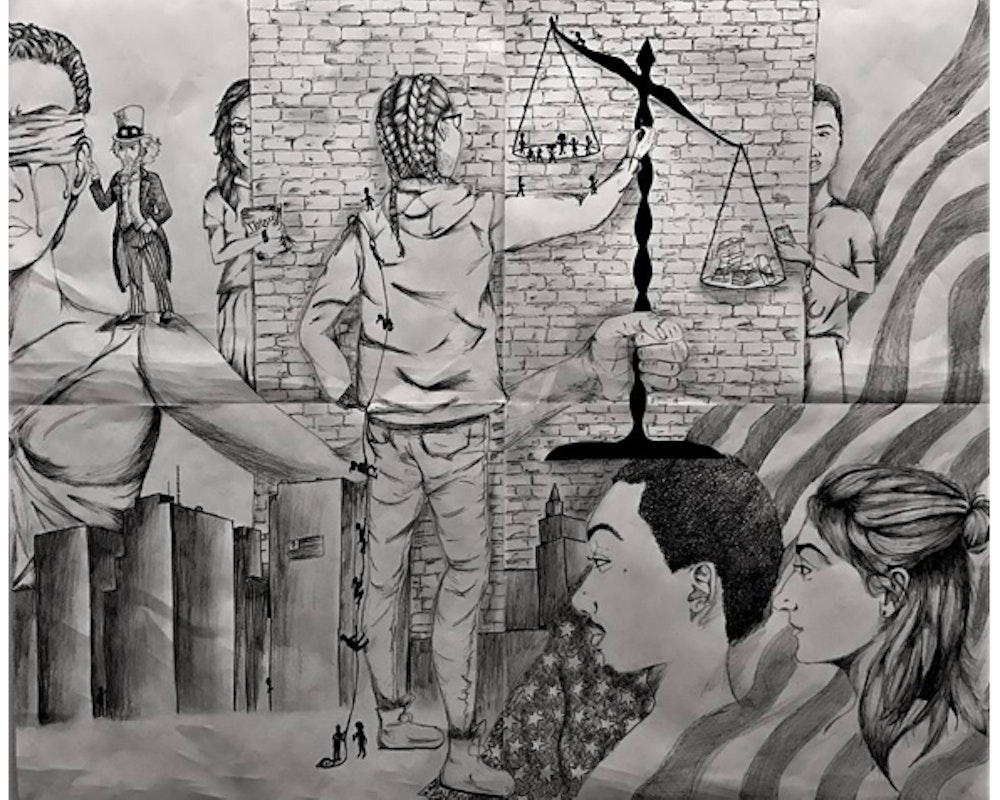
Despite all I learned after years in leadership roles at Imagining America—a robust network of publicly engaged scholars, artists, designers, humanists, and organizers—I still have to remind myself that the power of the arts, design, and humanities is for real. One of my students, Vivian A. Peralta Santana, a biology major destined to be a leading research scientist, opened my eyes afresh to how important art can be to sense-making. Vivian took the Local Citizenship in a Global World course, which asked students to make a creative learning artifact along with traditional assignments. Vivian’s drawing prominently features a young woman drawing the balance of justice on a wall. Community members come out of the shadows and climb the woman’s body. Lady Justice weeps as Uncle Sam whispers in her ear. To say the least, it is a visually and metaphorically dynamic expression. “Dean Eatman,” Vivian told me, “I must admit I spent most of my time on the drawing as part of the final class project.” Her art will soon be a mural in the new Honors Living-Learning Community building at Rutgers University–Newark.
—Timothy K. Eatman
Rutgers University–Newark
The textbook for my introductory, large-enrollment lecture course defines introversion as seeking solitude when you want to recharge. During a lecture, I said, trying to joke, “Introversion doesn’t mean you’re autistic or something.”
After class, a student emailed me to say, in part, “I was upset when you made a joke of autism today. My brother is autistic, and I’m in school to help people like him.” I wrote the student an apology. Then, with his permission (and after removing identifying content), I sent the apology to the class and cc’d the Disability Resource Center, proposing this incident as a lesson for other professors.
I have told this story to many colleagues, who almost always say, “Oh, sensitive kid—you were joking, big deal.” Actually, it is a big deal because I teach my students to choose their words with precision. Now, I’m more scrupulous about modeling what I teach.
—David Weber
University of North Carolina Wilmington
On the first day of a cotaught seminar on community, diversity, and faith, my colleague, Al, and I began by teaching an international gesture of peace, a series of symbolic movements accompanied by words: “I wish you peace [arms extended]. I wish you friendship [hands clasped]. I wish you love [hands crossed on the chest].”
Al first taught the gesture with the English narration. Then he said, “Let’s take the words away.”
Immediately, a student’s hand shot up.
“Dr. Al, I’m blind. If you take away the words, I can’t participate.”
As teachers, we cannot say, “My classroom is inclusive! My community is welcoming!” Rather, those we seek to include and welcome must be able to say, “I am welcomed. I belong.” True inclusion in the classroom, as in any other community, must be uniquely cocreated and recognized by its members.
—Naomi Yavneh
Loyola University New Orleans
I teach my students to choose their words with precision. Now, I'm more scrupulous about modeling what I teach.
Lead image caption and credit:Vivian A. Peralta Santana drew on the power of art for her Local Citizenship in a Global World course. Illustration courtesy Vivian A. Peralta Santana.